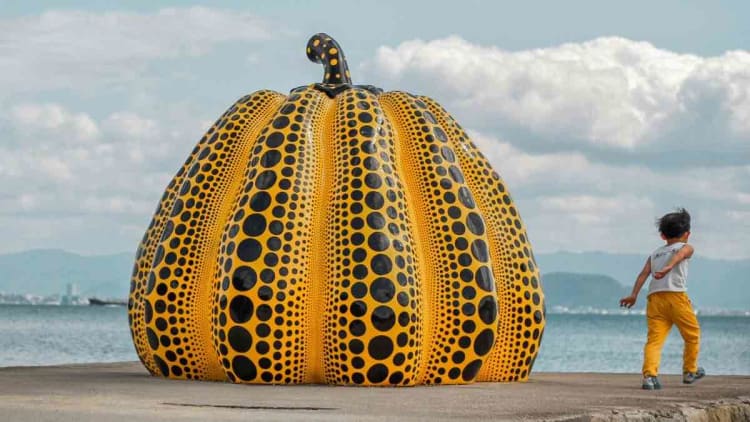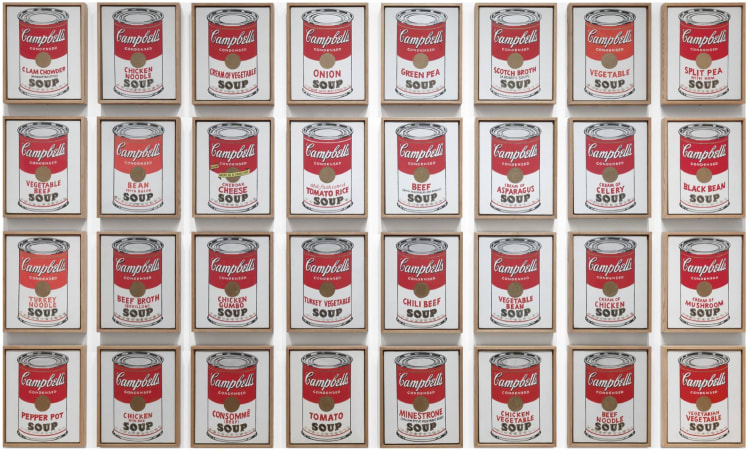Among the most powerful symbols of contemporary art, Yayoi Kusama's Pumpkin series is distinguished by its ability to capture the collective imagination through simple but haunting motifs. Like Banksy's Girl with Balloon or Andy Warhol's Campbell Soup Cans, Kusama's "Pumpkins" form an iconic, recognizable and universal series.
However, this motif is not trivial: the pumpkin that Kusama has been declining for several decades, comes to life through various techniques: sculptures, immersive installations, screenprints or paintings. This symbolism of the pumpkin, sometimes reassuring, sometimes hypnotic, is associated with the characteristic peas of the artist, revealing a unique and timeless vision.

Pumpkin by Yayoi Kusama: a work, a series, a unique vision
Yayoi Kusama's pumpkins, emblems of contemporary art, represent much more than just a recurring motif. By declining her Pumpkins in various forms - sculptures, meticulous screenprints, immersive installations - Kusama makes this squash a timeless symbol of repetition, infinity and contemplation.
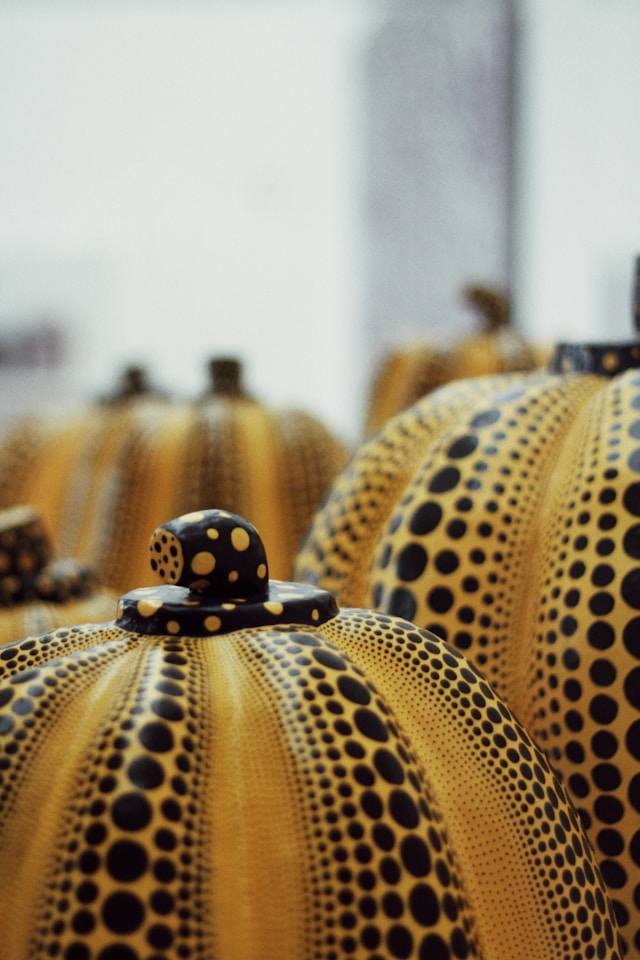
Several Pumpkins by Yayoi Kusama at the Serralves Foundation in Porto
Comparable to Andy Warhol's great classics in terms of notoriety and impact, this iconic series reflects the deep artistic quest of the Japanese, her exploration of forms and colors, and also her desire to offer viewers a complete sensory experience.
Also read: 8 things to know about Yayoi Kusama
A variety of techniques: sculptures and monumental installations
Yayoi Kusama began exploring the pumpkin pattern in the 1980s, declining it into sculptures and installations that made her iconic Pumpkin series emerge. Bronze, fiberglass, stainless steel, resin and ceramic: each material selected by the artist plays a decisive role in the way the work dialogues with light, space and the environment.
The first three-dimensional sculptures and monumental installations of pumpkins were created in the 1990s. They are distinguished by their imposing sizes and their palette of yellow and black polka dots, which have become visual emblems of Kusama's style. Thanks to their size and their disposition in unique places, these works invite spectators to approach them, to closely observe the regular and hypnotic motifs, creating an immersive and almost meditative experience.

Detail of a Pumpkin exhibited at the Yayoi Kusama Museum in Tokyo
Kusama thus manages to transform the pumpkin, a familiar and reassuring object, into a monumental entity where every detail of peas and each curve becomes a portal to infinity. The almost mechanical repetition of these motifs opens a poetic reflection on the passage of time, the infinite and our intimate link with the universe.
Screenprints: between simplicity and complexity
Kusama's Pumpkin screenprints are another part of this mythical series, allowing the artist to transpose the hypnotism of her peas to a more accessible and intimate format: paper. These prints, produced in limited editions, numbered and often signed by the artist, offer a unique insight into the artist's graphic universe. Screenprints, made in captivating chromatic palettes such as yellow and black, red and white, black and green or red and black, transmit serenity and passion.
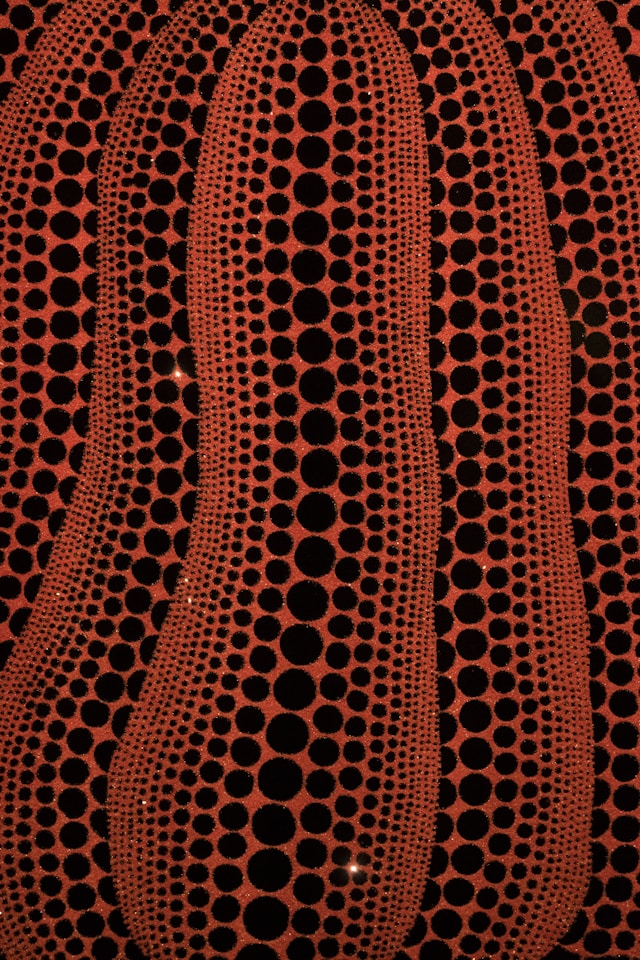
Detail of a red and black screenprint by Yayoi Kusama
In her screenprints, Kusama deploys a meticulous work where each pea and each curve are perfectly arranged to create a composition that seems infinite. Repetition and precision echo the artist's personal obsessions, transforming a simple motif into an invitation to meditation.

Another example in black and white
Monumental installations around the world
The scale of the Pumpkin series is fully revealed in its in situ installations, where each "Pumpkin" transforms the exhibition space into its own universe. The most iconic installation is undoubtedly the gigantic yellow and black pumpkin installed in 1994 on the island of Naoshima in Japan. Placed at the end of a pier, this giant sculpture reflects Kusama's deep connection with nature and the sea, creating a contrast between the sweetness of the pumpkin and the strength of the surrounding elements.

Yayoi Kusama's Pumpkin on the island of Naoshima
Other monumental installations took place in places such as the Hirshhorn Museum in Washington, the Victoria Miro in London and the M+ Museum in Hong Kong. These installations, far from being simple decorations, transform their environment, attracting visitors to a universe where repetition and peas encourage escape and contemplation.
Also read: Yayoi Kusama's famous pumpkin destroyed by the passage of a typhoon
Collaborations and cultural dissemination: the pumpkin, a new symbol of pop culture
In addition to the art scene, the Pumpkin series has established itself in popular culture thanks to strategic collaborations with luxury brands such as Louis Vuitton. In 2012, Yayoi Kusama partnered with the French fashion house to create a collection where her polka dots and squash adorn bags, accessories and clothing. This collaboration, entitled Yayoi Kusama x Louis Vuitton, marks a breakthrough in the world of fashion, reaching a wide audience and making Kusama's art accessible beyond galleries. Subsequently, this collaboration continued with the brand.
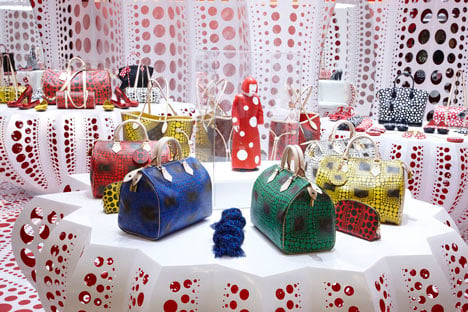
A London Louis Vuitton store in 2012 presenting the collaboration with Yayoi Kusama
The Pumpkin thus becomes a universal symbol, omnipresent in the media and social networks and an immediately recognizable icon of contemporary art. In 2021, an immersive installation at New York Botanical Garden, including illuminated pumpkins and spaces filled with peas, attracted more than 250,000 visitors. This global success testifies to the impact of Pumpkins in the heart of the public and how they transcend cultural barriers.
It should also be noted that this commercial success is to be qualified because experienced people from the world of art stand up against the LVMH group and its practices. Indeed, the group is often accused of recovering the image of certain great artists (and the resulting popularity...): Yayoi Kusama, Leonardo da Vinci, Jean-Michel Basquiat...
A work highly appreciated by collectors
In limited editions, in the form of unique paintings or sculptures, Pumpkins are now objects of desire on the art market. Limited editions (sculptures, screenprints...) are sought after by collectors around the world, while monumental sculptures are reserved for large public and private collections.
Acquiring a Kusama Pumpkin is integrating a part of the artist's poetic and captivating universe into his own collection. Whether through limited edition screenprint or an imposing sculpture, each piece bears the imprint of Kusama, her obsessive exploration of form, color and infinity.
Also read: 7 contemporary artists to collect before it's too late
Conclusion: Pumpkin, an iconic and timeless work
Yayoi Kusama's Pumpkins embody much more than just a recurring motif; they represent a deep artistic vision and a reflection on infinity, simplicity and serenity. With their monumentality and captivating colors, they fascinate both the general public and the most informed connoisseurs.
By declining her pumpkins through different mediums, Yayoi Kusama has made the pumpkin a universal symbol of contemporary art, celebrated around the world.
Discover the available works of Yayoi Kusama on Art Shortlist

